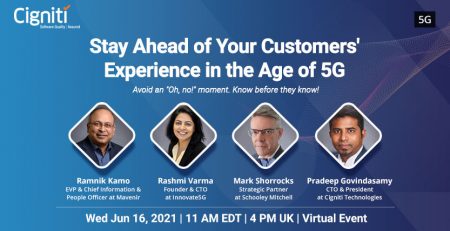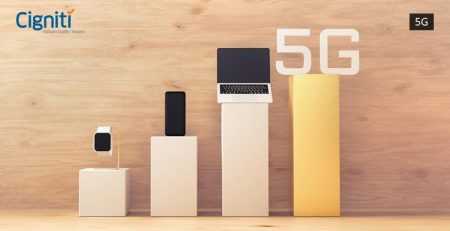5G – Myths vs Realities
“5G is coming! I saw the commercial!”
“No, 5G is already here. Didn’t you see the other commercial?”
“Yes, but I don’t have 5G, do you?”
“Yes, I have had it for the last year. Well, I think I have. What is 5G anyway?”
Have we ever seen anything so overhyped yet, at the same time, so misunderstood? Has there ever been a major technical advancement, that at the same time is already here, yet seemingly so far off in the future? We have been hearing about 5G for years. So much so that the initial excitement and promise have been somewhat muted by the never-ending pomp and circumstance across all the media channels we are continually subjected to by the major telecoms (anyone else looking forward to the retirement of AT&T’s Lily?).
Increasingly, we continue to get more questions from our clients – specific to digital assurance – on when they should start to worry about, and factor in, 5G as part of their digital journeys. In this blog, we attempt to dive deeper into the hype vs reality of 5G. (Spoiler alert – yes there is a lot of hype, (thanks again Lily), but the level of hype does not diminish the reality and “realness” of this next generation of mobile networks.
So, let’s dive in with three of the top myths vs realities of 5G…
5G Is Here!
I call this the “Should I be losing sleep over 5G?” category. It depends on who you ask – the carriers would say yes. But is that enough for the everyday enterprise to start building apps for 5G? Not necessarily. The current reality is that “4G native” apps (or “over the top” applications) perform quite well on 5G networks. We have done significant live network testing across a spectrum of applications from the App Store and Google Play Store, and we have yet to come across an application that does not perform better on a 5G network. This result came as no surprise to anyone, but rather as confirmation that 5G is unquestionably faster.
But when we look at the larger promise of 5G, the elements that support edge computing and network slicing, the answer to “Is 5G Here” on the Yes/No spectrum still leans more towards “No”. Despite what we hear from the major telecoms, the physical network infrastructure is still evolving. Not to mention, the understanding of how-to re-architect and re-factor to allow for edge and network slicing, is still unknown and misunderstood to many.
So yes, 5G is here in that we can actually get onto a 5G network with a 5G-enabled phone. But the totality of the promise of 5G is still out in front of us until the physical networks are up and running. And the knowledge and understanding of how to best incorporate these networks into the architecture of mobile apps and IOT devices is a steep learning curve that will take time to evolve. Which is a good segue to our next myth/reality.
My apps will be fine; I won’t need to refactor!
Yes, this is true… at least for today. But looking forward, this is clearly a myth. Once the aforementioned network readiness is established, it will slowly enable the opening of the floodgates as enterprises look to truly harness the power of 5G – for both the enterprise as well as for consumer and business enabling apps, respectively. Yes, applications and devices that are fairly static may not need to take advantage of all that 5G networks have to offer.
It is hard to imagine today – somewhat akin to envisioning the likes of Uber or Instacart before there was the internet and cloud computing. We had no basis for envisioning the use cases that underly these business models. With 5G, once the physical networks are in place, and once there is a deeper and broader understanding of how to leverage these networks as part of an integrated application/device architecture, the use cases will become much more apparent. And with that, we will experience the next horizon of application and device architecture that is no longer agnostic of the networks on which they run and operate. I think back to Kevin Costner’s famous line from the film Field of Dreams, “… if you build it, they will come…”. And when it does come, it will change the game with regard to how they are tested across the spectrum of UI/UX, performance, and security. This is where the maturation of the discipline and science of digital assurance will truly come into play.
Consumer 5G use cases don’t exist.
If we were to solely go by the claims of the telecoms, everybody with a mobile phone should be racing to upgrade their phones so they have access to 5G. But entertaining commercials aside, seemingly the only use cases that exist for the consumer are streaming and playing games on their mobile devices. And fair enough, we have suffered through slow, latency-intensive connections for long enough.
So, yes, it is true that there is not a broad and diverse set of consumer use cases today. The use cases and the subsequent business models that will evolve with 5G in place will result from the same innovation channels that brought us Web 2.0 and are bringing us into Web 3.0. Think about the metaverse and the heavy amount of data that will come into play with the new immersive user experiences that will present themselves. The next generation of mobile gaming that incorporates VR. The B2C apps that will finally introduce an immersive shopping or travelling experience through both VR and AR. All of this will only happen when 5G is established (that being, when there is a critical mass of users AND the physical network infrastructure is in place). And we are not there yet. So, while the 5G consumer landscape becomes murkier when we look beyond gaming and high-def video, we can be confident that 5G will serve as a tsunami of innovation just as we saw with Web 2.0.
So, in the end, it is not necessarily a matter of the myths vs realities of 5G – it is more about the timing. Everything we are hearing about 5G and the promise it holds is true. It will all just take more time for reality to catch up to the hype. And with that, we are encouraging all our clients that while they should not be stressed, they should certainly have their eyes wide open about how 5G will come into play. We are already working with multiple enterprises who are at least establishing baselines for their current apps in mixed 4G/5G environments, so they “know what they don’t know” about their current position.
Conclusion
Would you be interested in a 5G offering that can measure the totality of the customer experience along with providing a sentiment view on a given consumer’s experience? An offering that can help you take a lead in the digital race by generating a real-time digital customer satisfaction score and ratings/sentiment prediction? Precise analysis, eloquent usage of collected data, and a holistic approach are the virtues of Cigniti’s 5G Assurance offering to accelerate digital customer experiences.
To find out more, talk to our Digital Customer Experience Assurance experts. They will help you provide a solution for your business and will demonstrate how to scale the quality of experience for 5G services.





Leave a Reply